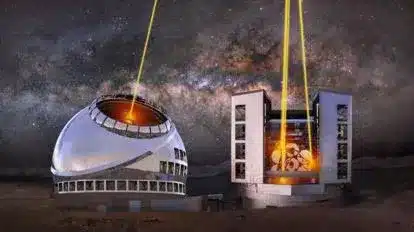About Thirty Meter Telescope:
- It is a revolutionary class of extremely large telescopes that will enable us to explore deeper into space and observe cosmic objects.
- It is an ambitious international project involving India, the United States, Canada, China, and Japan that aims to significantly advance our understanding of the universe.
- It is a next-generation astronomical observatory designed to provide unprecedented resolution and sensitivity with its massive 30-meter primary mirror, advanced adaptive optics system, and state-of-the-art instruments.
- Primary goals:
- Study the early universe and the formation and evolution of the first galaxies and stars after the Big Bang.
- Investigate the formation, structure, and evolution of galaxies across cosmic time.
- Study the relationship between supermassive black holes and their host galaxies.
- Investigate the formation of stars and planetary systems.
- Characterize exoplanets and study their atmospheres.
Key Features of the TMT
- Mirror System
- Primary Mirror: 30 meters in diameter, composed of 492 hexagonal segments.
- Secondary Mirror: Composed of 118 smaller hexagonal segments.
- Tertiary Mirror: 3.5 meters by 2.5 meters, positioned centrally within the primary mirror.
- The TMT will feature instruments like the Infrared Imaging Spectrometer (IRIS) and the Wide-Field Optical Spectrograph (WFOS) for various observations.
What is an Adaptive Optics System?
- The TMT’s AOS, known as the Narrow Field Infrared Adaptive Optics System (NFIRAOS), uses deformable mirrors and laser guide stars to correct atmospheric turbulence, enhancing image resolution.
- Indian scientists have developed a tool to generate a comprehensive all-sky catalogue of NIR stars for this system.
Q1: What is a galaxy?
It is a huge collection of gas, dust, and of stars and their solar systems. A galaxy is held together by gravity. Our galaxy, the Milky Way, also has a in the middle.
Source: What is Thirty Meter Telescope and why is it significant for India?
Last updated on January, 2026
→ Check out the latest UPSC Syllabus 2026 here.
→ Join Vajiram & Ravi’s Interview Guidance Programme for expert help to crack your final UPSC stage.
→ UPSC Mains Result 2025 is now out.
→ UPSC Notification 2026 is scheduled to be released on January 14, 2026.
→ UPSC Calendar 2026 has been released.
→ UPSC Prelims 2026 will be conducted on 24th May, 2026 & UPSC Mains 2026 will be conducted on 21st August 2026.
→ The UPSC Selection Process is of 3 stages-Prelims, Mains and Interview.
→ Prepare effectively with Vajiram & Ravi’s UPSC Prelims Test Series 2026 featuring full-length mock tests, detailed solutions, and performance analysis.
→ Enroll in Vajiram & Ravi’s UPSC Mains Test Series 2026 for structured answer writing practice, expert evaluation, and exam-oriented feedback.
→ Join Vajiram & Ravi’s Best UPSC Mentorship Program for personalized guidance, strategy planning, and one-to-one support from experienced mentors.
→ UPSC Result 2024 is released with latest UPSC Marksheet 2024. Check Now!
→ UPSC Toppers List 2024 is released now. Shakti Dubey is UPSC AIR 1 2024 Topper.
→ Also check Best UPSC Coaching in India

















